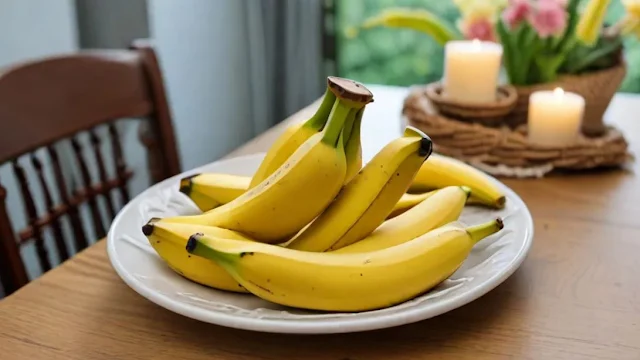Best Health Benefits of Bananas
Contents
Varieties:
Cavendish:- The most common variety found in supermarkets. It is sweet and firm.
Plantain:- Larger and starchier than the Cavendish, often used in cooking rather than eaten raw.
Red Banana:- Sweeter and smaller with a reddish-purple skin.
Lady Finger:- Smaller and sweeter than the Cavendish, also known as "baby bananas."
Blue Java:- Known for its unique blue skin and ice cream-like flavor and texture.
Pros:
- Nutritional Benefits:- Rich in potassium, vitamin B6, vitamin C, and fiber.
- Energy Boost:- Provides a quick source of natural energy.
- Digestive Health:- Helps regulate bowel movements and prevent constipation.
- Heart Health:- Potassium helps maintain blood pressure and heart function.
- Mood Enhancement:- Contains tryptophan, which the body converts into serotonin
Cons:
- High Sugar Content:- Can contribute to blood sugar spikes, particularly in individuals with diabetes.
- Allergic Reactions:- Some people may be allergic to bananas, experiencing symptoms like itching or swelling.
- Caloric Content:- While not high, excessive
consumption can contribute to weight gain.
Dishes
and Uses:
Raw:- Eaten as a snack or added to smoothies and fruit
salads.
Baking:- Used in banana bread, muffins, and cakes.
Cooking:- Plantains are fried, boiled, or baked for savory
dishes.
Desserts:- Bananas are used in puddings, ice creams, and as
a topping for pancakes and waffles.
Savory Dishes:- Added to curries or used in savory sauces.
Nutritional
Values (per 100g):
- Calories: 89
- Protein: 1.1g
- Fat: 0.3g
- Carbohydrates: 22.8g
- Fiber: 2.6g
- Vitamin C: 8.7mg
- Vitamin B6: 0.4mg
- Potassium: 358mg
- Magnesium: 27mg
- Skincare:- Banana peels are used to reduce acne, brighten skin, and soothe irritation.
- Hair care:- Banana masks can moisturize hair and improve shine.
- Natural fertilizer:- Banana peels are rich in nutrients, making them great for composting or as direct plant fertilizer.
- Polishing:- Banana peels can be used to shine shoes and silverware.
- Animal feed:- Bananas are used to feed livestock in some regions.
Bananas have several industrial uses beyond their culinary applications:
- Textile industry:- Banana fibers are used to create eco-friendly fabrics and textiles, particularly in countries like Japan and Nepal.
- Biodegradable products:- Banana waste, like peels and stems, can be used to produce biodegradable plates, cups, and packaging materials.
- Biofuels:- Banana waste can be converted into bioethanol, a sustainable fuel source.
- Paper production:- Banana fibers are used to make eco-friendly paper.
- Cosmetic industry:- Extracts from bananas are used in skin and hair care products.
These applications highlight the environmental potential of bananas.
Medicinal
Uses:
- Digestive Aid:- Helps in alleviating symptoms of ulcers and indigestion.
- Heart Health:- Regular consumption can help reduce the risk of heart disease.
- Muscle Cramps:- Potassium in bananas helps prevent muscle cramps.
- Mood Regulation:- Tryptophan in bananas can improve mood and reduce stress.
- Antioxidant Properties:- Contains antioxidants that help reduce oxidative stress and inflammation.
Dry Bananas have a variety of uses beyond snacking:
- Healthy snacks: Eaten as a convenient, long-lasting snack with concentrated nutrients.
- Culinary uses:- Added to cereals, trail mixes, desserts, or baked goods.
- Powdered form:- Ground into banana flour, used in gluten-free baking.
- Animal feed:- Fed to livestock due to their high nutritional content.
- Natural sweetener:- Used as a natural sweetening agent in smoothies, protein bars, and healthy treats.
- Cosmetic uses:- Incorporated into skincare masks for moisturizing and nourishing effects.
Dry bananas are a versatile product with wide-ranging applications.
Banana Dishes
Here are some popular banana dishes from around the world:
- Banana bread:- A moist, sweet bread made from mashed bananas.
- Banana pancakes:- Simple pancakes with mashed bananas for natural sweetness.
- Banana fritters:- Deep-fried banana slices, popular in many Asian countries.
- Banana pudding:- A creamy dessert layered with bananas, vanilla wafers, and custard.
- Banana chips:- Thinly sliced, fried, or baked bananas used as a snack.
- Banana smoothies:- Blended bananas with milk, yogurt, or other fruits for a nutritious drink.
Top Importers of Bananas
United States: $3.1 billion (18.5% of total imported bananas)
Germany: $1.2 billion (6.8%)
Mainland China: $1.1 billion (6.4%)
Japan: $961.2 million (5.7%)
Netherlands: $911.4 million (5.4%)
France: $883.2 million (5.2%)
Russia: $760.7 million (4.5%)
United Kingdom: $733.4 million (4.3%)
Belgium: $681.7 million (4%)
Italy: $624.8 million (3.7%)
Canada: $504.2 million (3%)
Poland: $376.4 million (2.2%)
Spain: $368.7 million (2.2%)
South Korea: $304.7 million (1.8%)
Argentina: $298.5 million (1.8%)
These 15 countries collectively accounted for 75.4% of all banana imports in 2023.
Regionally, Europe led banana imports with expenditures totaling $8.9 billion, representing 52.4% of the global total. North America followed with 21.5%, and Asia accounted for 20.7% of imports.
In terms of volume, the United States imported approximately 14 million tons of bananas annually.
These figures highlight the significant demand for bananas across various regions, with the United States, Germany, and China being the top importers.
Conclusion:
Bananas are a versatile and nutritious fruit that offer numerous health benefits. They can be enjoyed in various forms, from raw snacks to cooked dishes. Despite their high sugar content, their nutritional value makes them a healthy choice for most people when consumed in moderation. Whether for their taste, health benefits, or culinary versatility, bananas remain a favorite fruit around the world.
Thank you for visiting and reading this blog,









No comments:
Post a Comment
If you have any opinions, Let me know